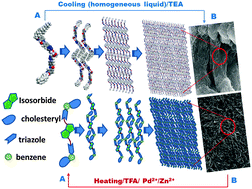Click chemistry-assisted, bis-cholesteryl-appended, isosorbide-based, dual-responsive organogelators and their self-assemblies†
Abstract
A new series of symmetric, bis-cholesteryl-appended, isosorbide derivatives (BCIE, BCIC2 and BCIC4) were designed as gelators to respond to changes in their environment and were synthesized successfully. Among these derivatives, BCIE can gel a wide variety of organic solvents (23 solvents), suggesting that BCIE acts as a more versatile gelator than BCIC2 and BCIC4. The CGC of the gels varies from 1.53 mM in 1-hexanol to 23 mM in pyridine. The results of the gelation ability in different solvents revealed that changing the linking group (ester/carbamate) attached to the cholesteryl units can produce a dramatic change in the gelation behavior of the compounds. The morphology of the as-formed organogels can be regulated by changing the types of organic solvents. The results from electron microscopy studies revealed that the gelator molecule self-assembled into different aggregates, from wrinkled fibers to dense fibers, with the change of solvents. The gels of BCIE in 1-hexanol and 1-octanol exhibited strong CD (circular dichroism) signals, indicating that the gelation induced supramolecular chirality in these gel systems. Secondary forces of van der Waals and π–π stacking (from both 1,2,3-triazole and aromatic units) played important roles in the aggregation of compounds in the solvents according to FTIR and variable temperature 1H-NMR analysis, and a mechanism for the gel formation was proposed. The gel-to-sol phase transition can be triggered by the addition of trifluoroacetic acid (TFA), and the gel state was obtained slowly (after 1 day) when neutralizing with triethyl amine (TEA), which indicated that the sol ⇄ gel phase transitions are tunable by pH, which is further supported by 1H-NMR and SEM analysis. In addition, the gel stability of BCIE was investigated using Cu2+, Cd2+, Ag2+, Fe3+, Hg2+, Mg2+, Pd2+, Al3+ and Zn2+, and the results showed that the gel-to-sol phase transition process could be selectively controlled by interaction with Pd2+ and Zn2+ because complexation with 1,2,3-triazoles destroyed the interactions between the triazoles, collapsing the gel, which was further evidenced by 1H-NMR and SEM analysis. However, the gel stability of BCIE was enhanced by the addition of Pd2+ and Zn2+ in the presence of pyridine, whereas the gel collapsed in other solvents, which may be due to the chelating effect of the pyridine moiety. Another interesting feature of this gel is that when using the gelator as a stabilizer, stable water in oil (W/O) gel-emulsions were created, in which styrene can be used as the continuous phase and water as the dispersed phase with the stabilizer in the continuous phase of only 2% (w/v). Gel-emulsions were observed with any ratio of water to styrene.


 Please wait while we load your content...
Please wait while we load your content...